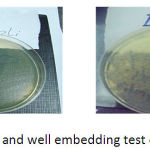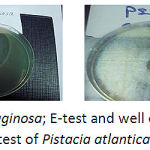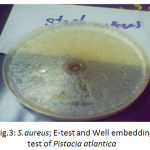Iraj Pakzad1,2*, Reza Azizian1, Farid Azizi Jalilian1,2, Morovat Taherikalani1,2, Nourkhoda Sadeghifard1,2 and Mojdeh Mahdi Kartalaie3
1Deparment of Microbiology , Faculty of Medicine, Ilam University of Medical Sciences, Ilam, Iran.
2Research Committee, Ilam University of Medical Sciences.
3Deparment of Epidemiology, Faculty of Medicine, Ilam University of Medical Sciences.
DOI : https://dx.doi.org/10.13005/bpj/395
Abstract
Antibacterial resistant microorganisms as agents which cause infection diseases are fourth cause of mortality throughout the world, therefore there is a huge attempt to deal with this issue. New antimicrobial agents design based on high bactericidal potential, high specificity and low cross-reaction. Herbal remedy as an ancient treatment is considerable. Previously, herbal extract were exploited to treat infections such as; Aloa vera, Thymus vulgaris, Allium sativum. This study is aimed to investigate the effect of Pistacia atlantica on bacteria and compare its effect with routine antibiotics. Sample size was determined 30 numbers per each bacteria by STATCALC software (EPI-Info). Hydro-extract prepared from Pistacia atlantica that collected from Zagros mountains. Disck diffusion and well embedding method recruited to investigate antibacterial effect. MIC test done for hydro-extract and antibiotics. Statistic analysis done by Square Chi test, t independent test, t-test and fisher test. MIC of Pistacia atlantica extract were 163µg/ml, 104.16µg/ml and 204.67µg/ml for E.coli, Pseudomonas aeruginosa and Staphylococcus aureus, respectively. These funding shown inhibition effect of this herbal extract but it indicate no affect on H.pylori. Funding indicate inhibit effect of hydro-extract on recruited bacteria except H.pylori thereby, it is suggested that phenol/chloroform-extracion could be have inhibit affect on H.pylori.
Keywords
H.pylori; Staphylococcus aureus; Pseudomonas aeruginosa; E.coli; Pistacia atlantica; Hydro-extraction
Download this article as:| Copy the following to cite this article: Pakzad I, Azizian R, Jalilian F. A, Taherikalani M, Sadeghifard N, Kartalaie M. M. Antibacterial Effect of Hydro-extract of Pistacia atlantica on Bacteria in In vitro. Biomed Pharmacol J 2013;6(2) |
| Copy the following to cite this URL: Pakzad I, Azizian R, Jalilian F. A, Taherikalani M, Sadeghifard N, Kartalaie M. M. Antibacterial Effect of Hydro-extract of Pistacia atlantica on Bacteria in In vitro. Biomed Pharmacol J 2013;6(2). Available from: http://biomedpharmajournal.org/?p=2652 |
Introduction
Herbal remedy as an ancient cure has been exploited for centuries. Recently, nearly to 1/3 of industrial drugs produced from herbal sources or modified after extraction(1). During last forty years scientists have been had huge effort to introduce novel antibiotics which have appropriate bactericidal effect and low toxicity therefore more than thousand ones had produced(2). Approximately 75% of world population administrate herbal remedy to deal with complaints(3). Hospital acquired infection could be very slight poisoning or life minatory infection(4, 5). Pseudomonas aeruginosa known as a minatory factor of life specially among patients with burn wound and Cystic fibrosis patients. Prevalence of H.pylori among adults in developing countries arise up to 80% that is contributed to gastrointestinal disorders such as Gastritis, Peptic ulcer and gastric adenocarsinoma(6-9). In the western of Iran, native people use herbal drugs to treat superficial, interior and deep infections. Pistacia antalica belongs to Anacardiaceae and as native herb used for herbal remedy. The aim of current study focused on the effect of hydro-extract of Pistacia atlantica on bacteria (10-12).
Matherial and Method
Extraction
Pistacia stlantica collected from Zagros mountains and after cleaning, drying and powdering. 1mg of powder added to 10ml DW and boiled for 15minutes then paper filter was used to filteration. Finally, Ben Murry 30ċ recruited to elimination process.
Sampling
30 clinical isolates for each bacteria isolated from hospitals and health publics of Ilam. Biochemical differential test exploited to determine bacteria. Biopsy samples cultured on clima agar with selective supplement at presence of CO2. 48hours culture of H.pylori prepared in peptone water. Antibiogram test done based on Kirby-bauer for all strains, Muller Hinton agar with 10% Sheep Blood used to antibiotic susceptibility test of H.pylori. Serial dilution of extract added to embedded well on media and also routine antibiotic disk used. Culture incubated 3 days at 37ċ in 5%-7% Co2 .
Antimicrobial Susceptibility determination
Minimum Inhibition Concentration (MIC) for all of four isolates done based on E-test for 10 antibiotics. 0.5 µF suspension of each isolates prepared and cultured on Muller Hinton agar then E-test strips laid on media. Diameter of no growth zone evaluated after 18 hours incubation at 35ċ. Standards of Clinical and Laboratory Standards Institute (CLSI) were used to determine susceptibility. E-test is a special strip that saturated by serial dilution of certain antibiotic. In this test bacteria cultured on media same as disk diffusion method and strips are laid on the media. Susceptible strain shown an oval shape zone of no growth that can be observed by naked eyes. Confluence of this oval shaped zone with strip indicates MIC.
To determine MIC of extract, 0.5 µF suspension of bacteria added to TSB and serial dilution of extracti then MIC read after 16-20 hours incubation. Inhibition effect of extract evaluated by agar diffusion method. Wells embedded on Muller Hinton agar and serial dilutions of extract pour into them after 20 hours incubation at 35ċ, zone of no growth evaluated. To analysis obtained data of MIC and E-test, Square Chi test, t independent test, t-test and fisher test done.
Result
Antibiogram result of E.coli indicates the lowest resistant to Imipenem whereas the highest resistant is shown to Amoxicillin by 83.3%. Pistacia atlantica extract shown inhibition effect against E.coli growth by MIC: 163µg/ml (Fig.1). Hydro-extract of Pistacia atlantica dose not indicate any effect on H.pylori.
 |
Figure 1: E.coli; E-test and well embedding test of Pistacia atlantica
|
The lowest resistant were to Mropenem and Amikacin while Pseudomonas aerugionsa has highest resistant for Trimethoprim/Sulfamethoxazole (TMP/SMX) by 6.6%. Pastacia atlantica extract has MIC: 104.16 µg/ml for P.aeruginosa. Diameter of no growth zone is investigated by various dilution that highest zone was 20mm by 100µl/ml of extract (Fig.2).
 |
Figure 2: P.aeruginosa; E-test and well embedding test of Pistacia atlantica
|
Staphylococcus aureus shown lowest and highest resistant to Vancomicin, Amoxicillin and Tetracycline (36.7%), respectively.
Fig.3 show the inhibitory effect of Pistacia atlantica on S.aureus by MIC: 204.67 µg/ml.
 |
Figure 3: S.aureus; E-test and Well embedding test of Pistacia atlantica
|
Discussion
Salehi et al indicate the effect of methanol-extract of Pistacia vera on E.coli. Obtained MIC of methanol-extract is higher than hydro-extract that demonstrate better efficiency of hydro-extract than methanol-extract(13). Masherghi et al shown that Rosmarinus extract have better efficiency than Pistacia atlantica extract on E.coli while Alcoholic extract of hypericum perforatum, carthamus tinctorius dose not have effect on it(12). Torabi et al funding demonstrate that essence of Eucalyptus kingsmillii and Eucalyptus salubris have less inhibitory effect than Pistacia atlantica extract on E.coli.(10)
Ramezani et al prove inhibitory potential of Pistacia atlantica extract for H.pylori by MIC: 1.55 mg/ml(11). Nakhaie et al indicate the methanol-extract of Citrus sinensis and both aqueous and methanolic extract of Cuminum cyminum and Artemisia dracunculus have strong affect on H.pylori growth and is better than Pistacia atlantica extract(14, 15). Current study shown that the hydro-extract of Pistacia atlantica fruit has inhibitory affect on P.aeruginosa by MIC:104/16 µg/ml and its peel extract has same potential. Among investigated bacteria, hydro-extract of Pistacia atlantica has more efficiency for S.aureus and regarding to comparison of antibacterial potential of this extract by routine antibiotics indicates that Cotrimoxazole has more inhibitory effect than studied extract on S.aureus. Hence, according to Salehi and Ramezani studies there is need to more investigate specially on methanol-extract or other kind of extract of this herb. (11)
References
- Eisenberg DM DR, Apple S, et al. Trend in alternative medicine use in the united states ,1990-1997, Result of a follow –up national survey. JAMA. 1998;280:1569-75.
- Bosze S. Medicinal plants in the Rainforest : Effects on biodiversity and indigenous people. Tropical ecosystem of Costa Rica. 2000:23-5.
- Wikipedia. Infectious disease Wikimedia foundation Inc. 2004.
- Goldman DA WR, Wenzel RP ,etal Strategies to prevent and control the emergence and spread of antimicrobial – resistance microorganisms in hospitals. JAMA. 1996;255:234-40.
- Davis J WV. The emrging infections. Academec press ,san diego. 1998:229-70.
- Crowe S. Helicobacter infection, chronic inflammation, and the development of malignancy. Curropin gastroenterol. 2005;21:32-8.
- Henry F. Antimicrobial Agents: Goodman gillmans pharmacological basis of therapeutic. Mcaraew Hill. 2001:1142-265.
- Leitner MG RJ, Byrne ME. Wound healing oral and tropical activity of Aloe. Journal of the American Pediatric. 1989;79:559-62.
- Karaman S.Digrak M RUIA. Antimicrobial and antifungal activity of essential oils of thymus revolutus celak from Turky Ethnopharmacol. 2001;76:183-6.
- Torabi.S.B NHBKM, Sadeghzadeh.L,. Investigation of components and antimicrobial effect of 10 Eucalyptus species on Micrococcus loteus and Escherichia coli, . Iranian Journal of Medical and Aromatic Plants. 2011;27(3):440-9.
- Ramezani M K-KM, Karimi-Fard V. Chemical composition and anti-Helicobacter pylori activity of the essential oil of Pistacia vera. Pharamaceutical Biology. 2004;42(7):488-90.
- Mashreghi.M MF. Comparison of antibacterial effect of Rosmarinus officinalis, hypericum perforatum, carthamus tinctorius on E.coli O157. J of Rafsanjan University of Medical Sciences. 2012;11(2):103.
- Salehi.M MS, Rais Nia. N, . Evaluation of antibacterial effect of methanol-extract of external peel of Pistacia vera. Microbial Biotechnology J of Qods Azad Uni. 2011;3(10):53-9.
- Nakhaie M.M RM, Karam Aldini.M.KH, Malekzadeh.F. Antimicrobial effetc of aqueous and methanolic extract of Cuminum cyminum L and Artemisia dracunculus L on H.pylori in in vitro. Iran University of Medical Sciences Journal. 2007;9(3):193-200.
- Nakhaie M.M. Antimicrobila effect of Citrus sinensis on H.pylori in in vitro. Microbial Biotechnology J of Qods Azad Uni. 2009;1(2):37-43.








